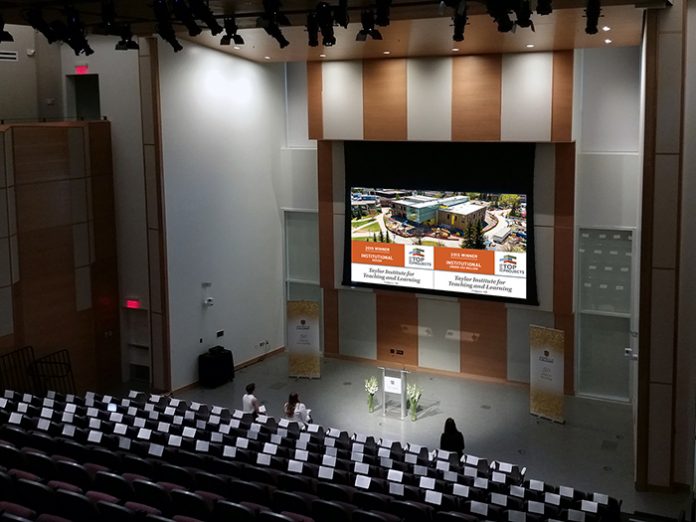Many universities set aside a room or two for teacher development; the University of Calgary has dedicated an entire two-story, 40,000-foot building to this crucial purpose. The new Taylor Institute for Teaching and Learning will, according to the university’s UToday website; ‘Transform teaching through the integration of teaching practices, learning technologies, and optimal designs for learning spaces’. The Institute features innovative architecture and active, flexible learning spaces that seamlessly incorporate the latest technology-including high-end audio.
Among these spaces is the Forum, a 370-seat multi-use space that is employed as a classroom, lecture hall, and entertainment space. Providing a flexible, extremely high-quality audio system that worked optimally in this important space proved to be challenging. To meet these challenges, US national consulting firm The Sextant Group designed an audio system based on Renkus-Heinz VARIAi-series modular point-source line arrays.
“One challenge is that the room is something of a large shoebox, about 40 feet wide by 75 feet deep, with high walls,” begins Sextant Group Senior Systems Designer Travis Seibel. “Retractable stadium seating pulls out of the back wall. A mezzanine goes around the perimeter of the room to provide additional seating; it adds five feet of depth and also houses a control room.”
Fortunately, the design team also worked on the acoustics. “The architects listened to everything we asked for, which was hugely helpful,” praises Seibel. “The Principal Design Architect, Matthew Lella of Toronto-based Diamond Schmitt Architects, has done a lot of theatre design, and you can see that influence.”
The overall ceiling height is 40 feet, too high to use a ceiling speaker system. “Given the room’s complexity and high ceiling, we decided on a line array for the main system,” confirms Seibel. “But because of the layout, we had to overshoot the location where the presenters stand. We could use modular point-source arrays as long as they were highly directional, and Renkus-Heinz’ VARIAi provides that.”
For the front main system, the Sextant Group team specified an LCR configuration, concealed in wall enclosures. “The client wanted high volumes,” recalls Seibel. “The VARIAi offers plenty of horsepower, and it has such a nice, clear, natural sound that it was a no-brainer.”
The left and right arrays employ five VARIAi full-range systems: The top three deliver 7° x 90° coverage, the next one down is 15° x 90°, and the bottom cabinet provides 22° x 90° dispersion. The centre array consists of six VARIAi cabinets, with four 7° x 90° systems on top and two 15° x 90° systems below. The centre array is primarily used for speech, although it will also support program music if desired. “We used EASE Focus software, along with design verification services from Renkus-Heinz, to predict the dispersion patterns we needed to make sure we had the right number and model of cabinets,” Seibel adds. Four Renkus-Heinz CF15S 15-inch non-powered subwoofers supply Sub-lows, set on the floor within speaker cavities.
The multi-cabinet VARIAi array helped with the retractable seating system, too. “We didn’t want loudspeakers pushing sound to the back of the room when nobody’s there,” Seibel asserts. “So when the facilities guys bring the seating out or in, a preset in the DSP automatically turns those speakers on or off.”
The client wanted to be able to watch movies in surround sound. But they didn’t need full theatrical surround, and the surround system only works with the stadium seating out, simplifying the design. Six Renkus-Heinz TRX61 two-way Complex Conic loudspeaker systems serve as left and right surrounds. The rear surrounds are a pair of Renkus-Heinz TRX82 two-way Complex Conic loudspeaker systems.
The mezzanine is served by one Renkus-Heinz IC7-II mechanically steerable, non-powered line array on each side, hidden behind fabric. The IC7-IIs can easily be turned on and off. “It really is a cool system,” Seibel admits.
Audio for the entire building is managed with five Biamp Tesira DSP servers, networked with AVB and located in a central equipment closet. A Dante network ties together the wireless mics and Yamaha QL-series console. Explains Seibel, “We used both AVB and Dante because with AVB, we don’t have to worry about channel count; we can send whatever we want across the five DSP units. But Dante has been more widely adapted than AVB, so if we add more external devices later, Dante makes sense. So we provided both.
Seibel praises the partners who worked on the project. “Matrix Video Communications Corp., out of Calgary, deserves a good bit of credit,” he enthuses. “We did the design and oversaw the implementation; the Matrix guys tied it all together and did the programming. They did excellent work. And the people at Contact Distribution, which supplied the Renkus-Heinz system, were great. They’re very focused on pro audio and video and take pride in their customer service and technical support.”
The Taylor Institute leadership is delighted with their new Renkus-Heinz system, and The Sextant Group is equally excited. “The Institute is a showpiece for us,” agrees Seibel. “We’ve always been champions of technology for learning, and in this building, we explore many different technological approaches. In the Forum, Renkus-Heinz loudspeakers ensured we could deliver an audio system that fully supports the Institute’s goals.”





